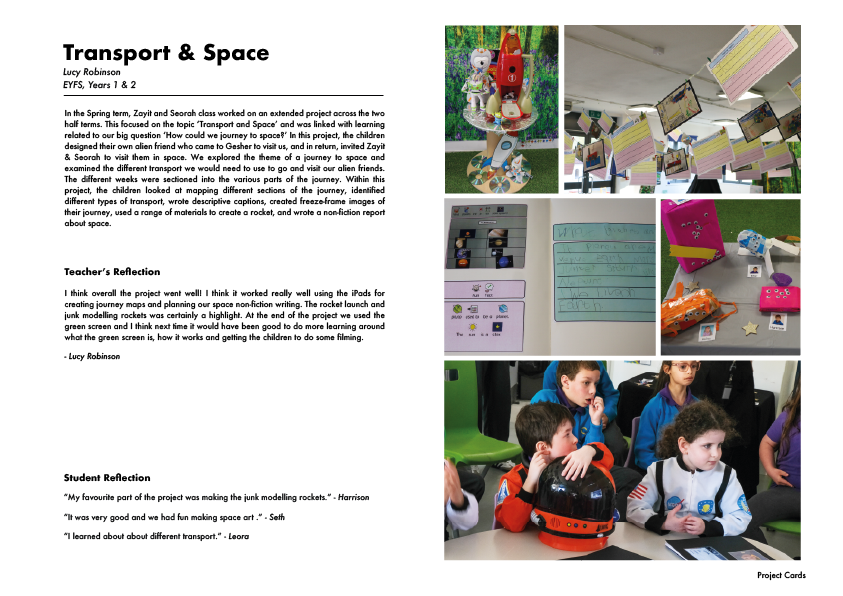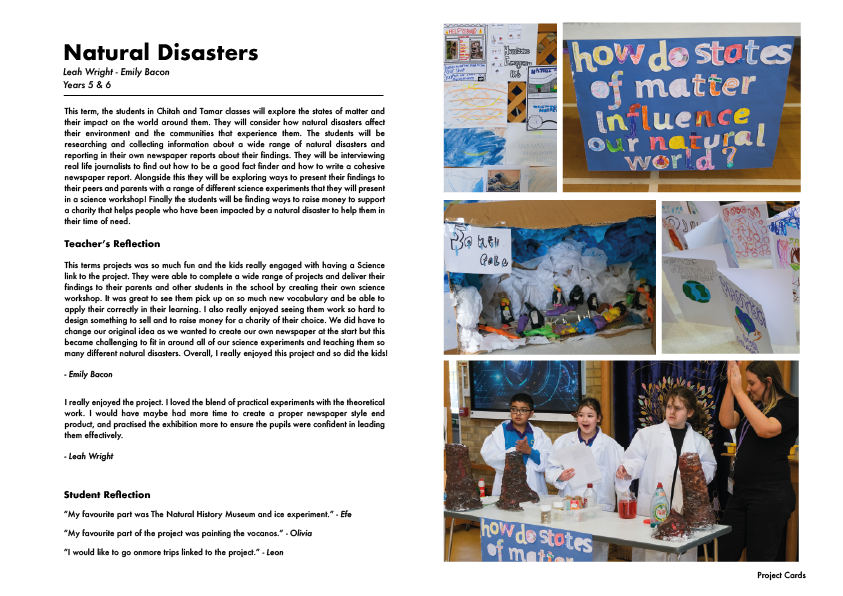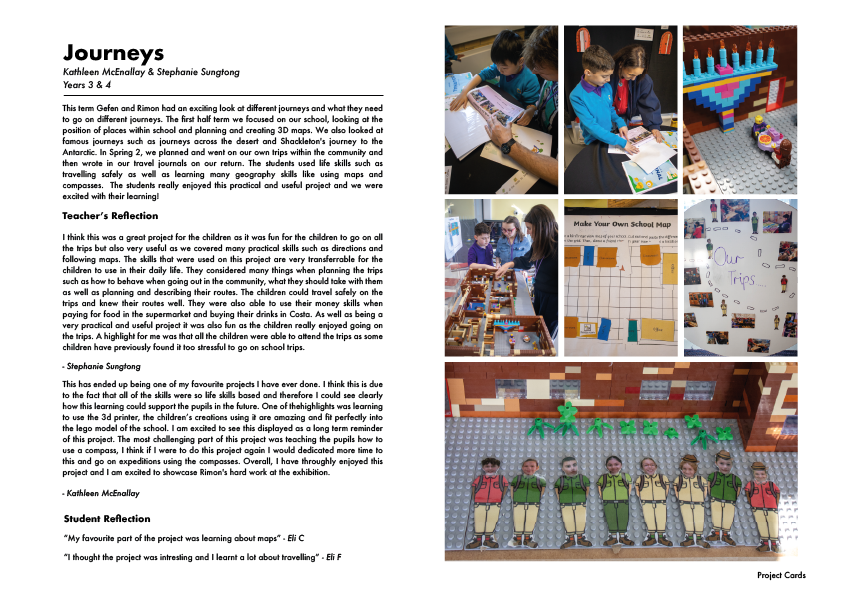Read the latest Gesher Gazette below! Please click on the link below to view the video links.
GesherClick on the link below to view the latest Gesher Gazette:
Read the latest Gesher Gazette below! Please click on the link below to view the video links.
GesherClick on the link below to view the latest Gesher Gazette:

In the Spring term, Zayit and Seorah class worked on an extended project across the two half terms. This focused on the topic ʻTransport and Spaceʼ and was linked with learning related to our big question ʻHow could we journey to space?ʼ In this project, the children designed their own alien friend who came to Gesher to visit us, and in return, invited Zayit & Seorah to visit them in space. We explored the theme of a journey to space and examined the different transport we would need to use to go and visit our alien friends. The different weeks were sectioned into the various parts of the journey. Within this project, the children looked at mapping different sections of the journey, identified different types of transport, wrote descriptive captions, created freeze-frame images of their journey, used a range of materials to create a rocket, and wrote a non-fiction report about space.
“I think overall the project went well! I think it worked really well using the iPads for
creating journey maps and planning our space non-fiction writing. The rocket launch and
junk modelling rockets was certainly a highlight. At the end of the project we used the screen screen and I think next time it would have been good to do more learning around what the green screen is, how it works and getting the children to do some filming
– Lucy Robinson
“ My favourite part of the project was making the junk modelling rockets.” Harrison
“It was very good and we had fun making space art” – Seth
“I learned about about different transport.” – Leora

This term, the students in Chitah and Tamar classes will explore the states of matter and
their impact on the world around them. They will consider how natural disasters affect
their environment and the communities that experience them. The students will be
researching and collecting information about a wide range of natural disasters and
reporting in their own newspaper reports about their findings. They will be interviewing
real life journalists to find out how to be a good fact finder and how to write a cohesive
newspaper report. Alongside this they will be exploring ways to present their findings to
their peers and parents with a range of different science experiments that they will present
in a science workshop! Finally the students will be finding ways to raise money to support a charity that helps people who have been impacted by a natural disaster to help them in
their time of need.
This terms projects was so much fun and the kids really engaged with having a Science
link to the project. They were able to complete a wide range of projects and deliver their findings to their parents and other students in the school by creating their own science
workshop. It was great to see them pick up on so much new vocabulary and be able to
apply their correctly in their learning. I also really enjoyed seeing them work so hard to
design something to sell and to raise money for a charity of their choice. We did have to
change our original idea as we wanted to create our own newspaper at the start but this
became challenging to fit in around all of our science experiments and teaching them so
many different natural disasters. Overall, I really enjoyed this project and so did the kids!
– Emily Bacon
“My favourite part was The Natural History Museum and ice experiment.” – Efe
“My favourite part of the project was painting the volcanos.” – Olivia
“I would like to go on more trips linked to the project” – Leon

This term Gefen and Rimon had an exciting look at different journeys and what they need
to go on different journeys. The first half term we focused on our school, looking at the
position of places within school and planning and creating 3D maps. We also looked at
famous journeys such as journeys across the desert and Shackleton’s journey to the
Antarctic. In Spring 2, we planned and went on our own trips within the community and
then wrote in our travel journals on our return. The students used life skills such as
travelling safely as well as learning many geography skills like using maps and
compasses. The students really enjoyed this practical and useful project and we were
excited with their learning!
Teacher’s Reflections
This has ended up being one of my favourite projects I have ever done. I think this is due to the fact that all of the skills were so life skills based and therefore I could see clearly how this learning could support the pupils in the future. One of thehighlights was learning to use the 3d printer, the childrenʼs creations using it are amazing and fit perfectly into the lego model of the school. I am excited to see this displayed as a long term reminder of this project. The most challenging part of this project was teaching the pupils how to use a compass, I think if I were to do this project again I would dedicated more time to this and go on expeditions using the compasses. Overall, I have throughly enjoyed this project and I am excited to showcase Rimon’s hard work at the exhibition.
– Kathleen McEnallay
“My favourite part of the project was learning about maps” – Eli C
“I thought the project was interesting and I learnt a lot about travelling” – Eli F
Our students have been working hard on a cross-curricular PBL project exploring the theme “How Can I Develop Self-Discipline in My Everyday Life?” In humanities, they researched and created Olympic timelines, while in English, they wrote detailed athlete profiles, which were later brought to life through role-played interviews. Building on this, students wrote and recorded narrative videos exploring self-discipline in sports, drawing on their own reflections and storytelling skills. The project culminated in the creation of a Vimeo channel, where their Olympic timelines, athlete interviews, and self-discipline narratives were shared a fantastic showcase of their learning, creativity, and collaboration.
“The project was a great success, and it was fantastic to see students engaging so well across different subjects. A real highlight was the athlete interviews, where students brought their profiles to life and developed their confidence in presenting. I was also really proud of how they tackled the narrative videos, especially those who find writing challenging, as it gave them a chance to share their ideas creatively.
The most challenging part was keeping the project’s focus clear as students moved between subjects, and some needed extra support with the recording and editing process. Next time, I’d build in more time to practise these technical skills and allow more opportunities for peer feedback earlier on, particularly during the writing stage. That said, I wouldn’t change the collaborative and creative elements of the project, as these really helped students stay engaged and take pride in their work. Overall, it was a rewarding experience, and the final videos on the Vimeo channel were a brilliant showcase of their hard work and creativity.”
– Aymane Hamidi
“The project taught If I’m having big emotions I can ask some one to help me and we like having good fun and I will might need some help if i need.” – Zac
“The project was great but a bit stressful when the internet was a bit funny and laggy and i almost lost my whole entire work.” – Bobby
“My highlight of the project was making my video because it was incredible and really fun. This is because it taught me a new skill of how to use stop motion which I have never used before..” – Aaron
Our first project this year was looking at the Stone Age. We looked at how people lived in the Stone Ages but also thought about how this compared to the way we live now. We learnt about the different lives of stone age people including how they dressed, the food they ate and the houses they lived in. We used all this information to create our own stories. The stories were then made into a simple coding programme called Scratch Junior. The children were able to add and change the characters, the background and move the characters around. The children were therefore able to use modern technology to present their knowledge on the lives of people in the past. We also used this idea in Jewish Studies looking at stories from the Torah and how we can use the messages from these stories in our day to day lives. In Life Skills the children were also thinking about how they can survive by looking at basic everyday skills of making their bed, washing their hands and hanging up their clothes.
“I feel that this was a successful project as the children were able to learn about the lives of people who lived a long time ago and how they survived and compare that to our lives. I feel the trip to Chiltern Open Air Museum was a success as the trip was very practical and interactive and the children could try out skills they would have used in the Stone Ages such as making a fire and making a basic shelter. The children also enjoyed transforming their Stone Age story into a Scratch Junior coding project and using the different coding techniques although I feel this was a bit tricky for the less able students who just wanted to play rather than create a specific coding project!”
– Stephanie Sungtong
“My favourite part of the project was the fossils” – Adam
“I felt really happy with my sone age story” – Kingsley
“My favourite part was using Scratch Junior for my project.” – Eli
“I would create longer pieces of work next time.” – Eli F
Read the latest Gesher Gazette below! Please click on the link below to view the video links.
GesherClick on the link below to view the latest Gesher Gazette:
Read the latest Gesher Gazette below! Please click on the link below to view the video links.
GesherClick on the link below to view the latest Gesher Gazette:
Read the latest Gesher Gazette below! Please click on the link below to view the video links.
GesherClick on the link below to view the latest Gesher Gazette:
Read the latest Gesher Gazette below! Please click on the link below to view the video links.
GesherClick on the link below to view the latest Gesher Gazette: